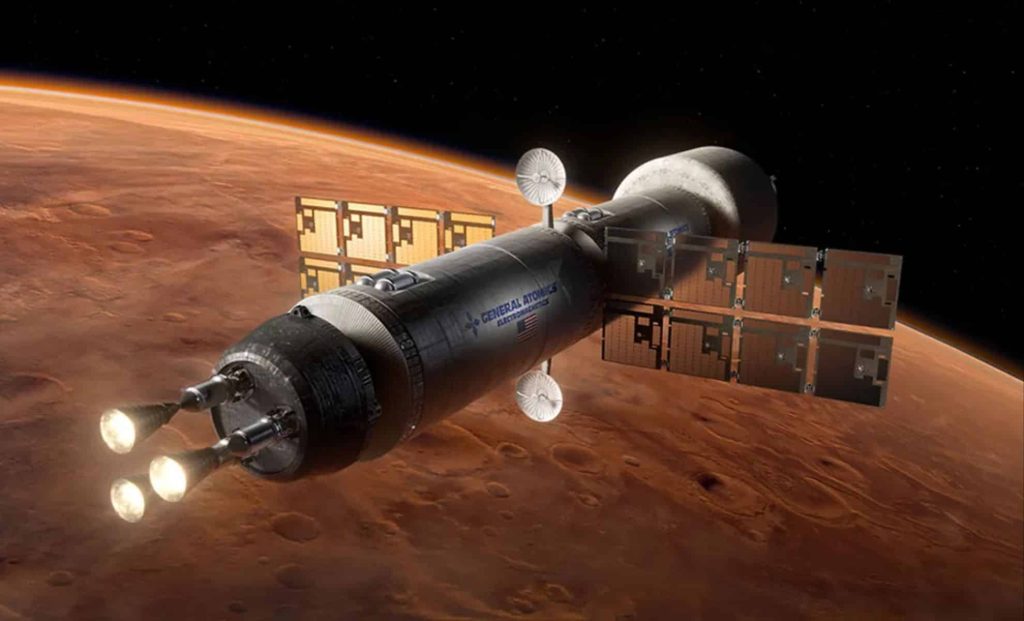NASA Tests Revolutionary Nuclear Propulsion Fuel That Could Take Humans to Mars in Just 45 Days – The Daily Galaxy –Great Discoveries Channel

NASA has successfully tested a revolutionary nuclear thermal propulsion fuel that could cut the travel time to Mars to just 45 days. This breakthrough, tested at the Marshall Space Flight Center, represents a pivotal advancement in space exploration technology. What could this mean for the future of human missions to the Red Planet?NASA has achieved a critical milestone in space exploration with the successful testing of advanced nuclear thermal propulsion (NTP) reactor fuel at its Marshall Space Flight Center (MSFC). This breakthrough technology, developed in collaboration with General Atomics Electromagnetic Systems (GA-EMS), has the potential to drastically reduce the travel time for human missions to Mars, cutting it from the current six months to just 45 days. The implications for space exploration are profound, with faster travel times addressing significant challenges related to astronaut safety, mission logistics, and deep-space exploration.At the core of this groundbreaking innovation lies a technology that is vastly more efficient than conventional chemical propulsion systems. According to the US Office of Nuclear Energy, “NTP systems work by pumping a liquid propellant, most likely hydrogen, through a reactor core. Uranium atoms split apart inside the core and release heat through fission. This physical process heats up the propellant and converts it to a gas, which is expanded through a nozzle to produce thrust.”This process not only allows for significantly greater efficiency but also enables spacecraft to achieve much higher speeds. Traditional chemical rockets rely on combustion to generate thrust, which is far less energy-efficient compared to the fission process driving NTP systems. The ability of nuclear thermal propulsion to achieve speeds two-to-three times faster than chemical rockets is a game-changer for long-duration missions.The recent tests at NASA’s Compact Fuel Element Environmental Test (CFEET) facility simulated the extreme conditions of deep-space operation. The fuel was subjected to rapid thermal cycling in hydrogen-rich environments at temperatures exceeding 2,727°C (4,940°F). These conditions replicate the environment the reactor core would encounter during operation in space.One of the most significant obstacles to human Mars missions is the immense distance between Earth and the Red Planet, which averages 140 million miles. Current chemical propulsion systems require approximately six months for a one-way trip, creating a host of logistical and safety challenges.Astronauts embarking on such a journey face extended exposure to cosmic radiation, the potential for equipment malfunctions, and limited medical support. “Facing a communication delay of up to 20 minutes one way, the possibility of equipment failures or medical emergencies, and a critical need to ration food and supplies, astronauts must be capable of confronting an array of situations with minimal support from teams on Earth,” NASA officials explained.Reducing travel time to as little as 45 days with NTP technology could mitigate many of these risks. Faster journeys mean reduced radiation exposure, fewer consumables, and a shorter window for technical malfunctions to occur. This advancement significantly enhances the feasibility of safe and efficient human exploration of Mars and beyond.The recent tests conducted by GA-EMS in collaboration with NASA represent a major leap forward in demonstrating the viability of NTP fuel. Scott Forney, president of GA-EMS, emphasized the importance of the results: “The recent testing results represent a critical milestone in the successful demonstration of fuel design for NTP reactors. Fuel must survive extremely high temperatures and the hot hydrogen gas environment that an NTP reactor operating in space would typically encounter. We’re very encouraged by the positive test results proving the fuel can survive these operational conditions, moving us closer to realizing the potential of safe, reliable nuclear thermal propulsion for cislunar and deep space missions.”Further highlighting the significance of this achievement, Dr. Christina Back, vice president of GA-EMS Nuclear Technologies and Materials, explained: “To the best of our knowledge, we are the first company to use the compact fuel element environmental test (CFEET) facility at NASA MSFC to successfully test and demonstrate the survivability of fuel after thermal cycling in hydrogen representative temperatures and ramp rates.”GA-EMS also conducted additional tests at its own laboratory, which confirmed the fuel’s performance in non-hydrogen environments. “We’ve also conducted tests in a non-hydrogen environment at our GA-EMS laboratory, which confirmed the fuel performed exceptionally well at temperatures up to 3000 K (2,727°C, or 4,940°F), which would enable the NTP system to be two-to-three times more efficient than conventional chemical rocket engines,” Back continued.The successful testing of NTP fuel marks a turning point in the development of advanced propulsion technologies. With the promise of faster travel times and greater efficiency, nuclear thermal propulsion opens up new possibilities for deep-space exploration. Scott Forney highlighted the broader implications: “We are excited to continue our collaboration with NASA as we mature and test the fuel to meet the performance requirements for future cislunar and Mars mission architectures.”The potential applications of NTP technology extend beyond Mars. Faster propulsion systems could enable more ambitious missions to the outer planets, as well as play a key role in the establishment of sustainable human habitats on the Moon and Mars. By drastically reducing travel time and increasing the payload capacity of spacecraft, NTP systems could support the long-term vision of space agencies to expand humanity’s presence beyond Earth.While the test results are promising, further research and development are needed to refine the technology and integrate it into upcoming space missions. NASA is expected to continue working with industry partners like GA-EMS to optimize NTP systems and prepare them for operational use. With upcoming projects like the Artemis program and potential Mars missions in the 2030s, NTP technology could play a pivotal role in shaping the future of human space exploration.As NASA and its partners continue to push the boundaries of propulsion technology, the dream of faster, safer, and more efficient interplanetary travel moves closer to reality. The successful testing of NTP fuel marks not just a technical milestone but also a profound step forward in humanity’s quest to explore the cosmos.Got a reaction? Share your thoughts in the commentsEnjoyed this article? Subscribe to our free newsletter for engaging stories, exclusive content, and the latest news.Comment Save my name, email, and website in this browser for the next time I comment.
© 2024 | Daily Galaxy | All rights reserved






